GULL BAY FIRST NATION Ont. - It had been 57 years since the humming of the Gull Bay First Nation diesel generation station was first heard by residents.
On Friday, it officially came to an end as project coordinator A.J. Esquega addressed a crowd in front of the new Giizis Energy solar storage microgrid facility.
The micro grid is the first of its kind in Canada, and after decades of hostile relations, Ontario Power Generation has helped Gull Bay First Nation become the first remote community in Canada to utilize renewable energy. The grid will help reduce massive amounts of carbon dioxide emissions caused by diesel generation, and will power the entire First Nation while the sun is shining.
The people behind the project are hoping it’s what the future will look like on remote First Nation communities in Canada.
“We all know what the impact global warming is having in our communities,” Gull Bay First Nation chief Wilfred King said on Friday.
“We feel that the generation of diesel has caused enormous harm to our community. We want to get off it and this is the first step.”
Reconciling troubled past
Gull Bay First Nation, also known as Kiashke Zaaging Anishinaabek, is a First Nations community located nearly 200 kilometers north of Thunder Bay, situated on the western shores of Lake Nipigon.
In the 1920s and 1940s, dam construction along the Nipigon and Ogoki River caused flooding on the traditional Gull Bay First Nation lands. The dams were constructed by Ontario Power Generation.
King told Dougall Media in 2010 that elders within Gull Bay First Nation still have memories of graves being desecrated during dam construction. A significant amount of shoreline on the First Nation was also lost.
In 2014, OPG and Gull Bay reached a grievance settlement worth $12.5 million, where OPG also issued an apology for the dam construction.
On Friday, leadership from both parties spoke highly of one another, as the two officially announced the completion of a first-of-its-kind micro grid.
First-of-its-kind grid
Across the road from the diesel station, the sun beams down on 1,200 newly built solar panels. The sign on the fence surrounding the panels reads 'Canada’s first fully-integrated, remote renewable, energy-storage micro grid.'
National Chief of the Assembly of First Nations Perry Bellegarde asked the audience on Friday what the number one question is going into October's federal election.
“Climate change."
“This First Nation is doing what everybody says we have to do, which is to protect the planet,” Bellegarde said.
The solar energy grid won’t completely eliminate reliance on diesel generation, but it will reduce diesel generation by 25 per cent annually. It will keep 400,000 tonnes of carbon dioxide emissions from entering the atmosphere.
During daylight hours, 100 per cent of Gull Bay's energy needs will be provided by the micro grid, with the diesel generator acting as a backup.
“Our people have lived off the environment since the time of memorial, and we still utilize the land quite extensively,” King said.
“Eventually we’d like to be 100 per cent off diesel... That’s the goal of this project.”
King's leadership
The $8 million project was entirely funded by external partners including OPG, HydroOne, and federal and provincial levels of government.
Chief King, addressing the crowd on Friday, said he wouldn’t settle for anything less than 100 per cent ownership, and didn’t want any of the cost to fall at the hands of the First Nation.
“I think that’s so crucial. First Nations have to take 100 per cent ownership of these facilities,” King said.
Over 300 First Nation communities in Canada rely on diesel generation. King believes the solar power micro grid is the future of powering remote First Nation communities.
“We’ve had a lot of inquiries. We’re willing to share our experiences, our knowledge. There’s a lot of communities, not just in Canada, but in the world that could benefit from this type of development," King said.
“I think a lot of First Nations are going to look to the leadership here to replicate what’s being done here,” said Belgrade.
In the long-term, the community is looking at hydro and geothermal opportunities to work towards the complete abandonment of diesel generation.
